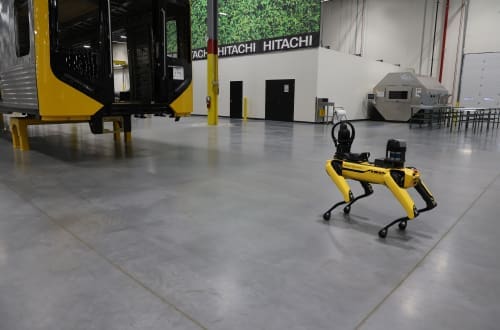- Services
Technology Capabilities
Technology Capabilities- Product Strategy & Experience DesignDefine software-driven value chains, create purposeful interactions, and develop new segments and offerings.
- Digital Business TransformationAdvance your digital transformation journey.
- Intelligence EngineeringLeverage data and AI to transform products, operations, and outcomes.
- Software Product EngineeringCreate high-value products faster with AI-powered and human-driven engineering.
- Technology ModernizationTackle technology modernization with approaches that reduce risk and maximize impact.
- Embedded Engineering & IT/OT TransformationDevelop embedded software and hardware. Build IoT and IT/OT solutions.
- Industries
- GlobalLogic VelocityAI
- Insights
BlogsDecember 16, 2024Gene LeybzonAccelerating Digital Transformation with Structured AI Outputs
This code produces the following output that can be imported into the candidate trackin...
 BlogsOctober 30, 2024Yuriy Yuzifovich
BlogsOctober 30, 2024Yuriy YuzifovichAccelerating Enterprise Value with AI
Discover how financial services integrations are transforming from standalone offerings...

- About Us
Press ReleaseGlobalLogicSeptember 23, 2025Hitachi agrees to acquire German data and AI services firm ...
Strengthening GlobalLogic’s data and consulting capabilities and expanding footprint in...
 Press ReleaseGlobalLogicSeptember 10, 2025
Press ReleaseGlobalLogicSeptember 10, 2025GlobalLogic and Ericsson Deploy Private 5G Network at Hitachi ...
The new infrastructure is the digital backbone of the Hagerstown plant, enhancing effic...

- Careers
Published on May 29, 2025Engineering for Change: How Adaptive Platforms Will Define Financial Services Leadership
View all articles Michael LewandowskiPrincipal, Financial Services Lead at MethodShareRelated Content
Michael LewandowskiPrincipal, Financial Services Lead at MethodShareRelated Content GlobalLogic1 December 2025
GlobalLogic1 December 2025 GlobalLogic27 November 2025View All Insights
GlobalLogic27 November 2025View All Insights GlobalLogic19 November 2025Recommended authorsDirector, Industrial BU GSPSenior Vice President & Head of EMEAView all authorsVice President & Consumer Business, Americas GlobalLogic
GlobalLogic19 November 2025Recommended authorsDirector, Industrial BU GSPSenior Vice President & Head of EMEAView all authorsVice President & Consumer Business, Americas GlobalLogicLet's start engineering impact together
GlobalLogic provides unique experience and expertise at the intersection of data, design, and engineering.
Get in touchAI-Powered SDLCGenAITransformation AdvisoryFinancial ServicesToday’s financial institutions are being pushed to move faster, scale smarter, and operate with greater resilience. In our previous two posts, we explored the first two forces driving that shift: Code and Change. Code represents the intelligent foundation: cloud-native platforms, AI-driven workflows, and automation as core engineering principles. Capital is the dynamic flow of value: embedded finance, tokenized assets, and new business models built to thrive in distributed ecosystems.
But to scale either one, institutions must embrace the third—and perhaps most critical—force in our 3Cs shaping the future of Financial Services: Change.
Change is no longer an outcome of transformation. It’s a designed capability.
The firms that are truly advancing—those realizing the full value of their AI investments or reinventing how they monetize products—are not just building smarter platforms. They’re engineering for adaptability from the ground up.
In today’s environment, agility isn’t a feature. It’s a foundational trait. Regulatory velocity, shifting customer expectations, and emerging technologies are compressing decision windows and raising the cost of delay. The ability to adapt in real time—securely, intelligently, and at scale—will define tomorrow’s financial leaders.
That’s why the future won’t be built on transformation projects alone. It will be shaped by institutions that treat Change not as a phase, but as a platform capability that is engineered to respond, evolve, and accelerate without disruption.
Change Isn’t Episodic. It’s Engineered.
Change isn’t something financial institutions react to; it’s the environment they operate in. Regulatory demands, technological breakthroughs, and rising customer expectations are converging, forcing firms to move from episodic transformation to continuous adaptability.
Regulatory shifts are leading the charge. Consumer Duty in the UK, FedNow in the US, and global frameworks like Basel III and ESG are turning compliance into a real-time discipline. It goes far beyond annual audits to continuous oversight by default.
Technology is compounding the pace. GenAI, real-time payments, and tokenized assets are redefining how financial services are built and delivered. Most legacy systems weren’t designed for this velocity.
And customers now expect more than speed; they demand relevance, trust, and
personalization at every touchpoint. To keep up, leaders must think differently. Agility isn’t a process improvement. It’s a platform requirement.
Where Change Becomes Advantage: 3 Capabilities Separating Adaptive Leaders from Reactive Followers
Agility doesn’t happen at the edge; it’s built into the core. For financial firms, that means engineering adaptability across three fronts: how they govern risk and compliance, how they build and scale resilient systems, and how their teams operate day-to-day. Here’s what that looks like in action:
- Regulatory Agility
Compliance is no longer a function at the finish line. It’s becoming a built-in capability—one that evolves alongside regulation and integrates directly into digital operations.
Picture a lending platform that adapts instantly to new fair lending guidelines by updating model policies via code. Or a transaction engine that flags potential fraud or ESG breaches in real time, based on continuously updated regulatory thresholds.
With modular architectures and policy-as-code in place, financial institutions can move from reactive compliance to systems that are proactive and provable by design.
- Resilience at the Core
Modern resilience means more than uptime. It’s the ability to absorb shocks, protect trust, and adapt infrastructure without disruption.
This might look like a customer service platform with embedded model validation tools that ensure every AI-generated response meets audit standards. Or a risk analytics engine that automatically triggers review workflows when outlier data is detected in portfolio monitoring.
With integrated observability and real-time testing frameworks, resilience becomes a continuous state, not an emergency response.
- Organizational Readiness
Technology can scale only as fast as the teams behind it. That’s why truly adaptive organizations are rethinking how they structure teams, deliver products, and govern innovation.
Think of product squads aligned around customer journeys, supported by shared APIs, design systems, and data platforms. Or risk and compliance experts embedded in development teams to co-author change, rather than enforce it after the fact. Think of product squads aligned around customer journeys, supported by shared APIs, design systems, and data platforms. Or risk and compliance experts embedded in development teams to co-author change, rather than enforce it after the fact.
These models flatten silos, accelerate delivery, and embed transformation into everyday operations—including intelligent, embedded change management that equips teams with the tips, tools, and behaviors needed to drive adoption and achieve business impact.
This is what it means to engineer for change; not just to respond, but to anticipate and accelerate through it. And while the principles are clear, the real value is in how they’re applied. Here’s what that looked like for one financial services organization that treated adaptability not as a constraint, but as a competitive edge.
From Mandate to Momentum: Real-World Agility in Action
A leading UK retail bank faced a complex challenge: implement Strong Customer Authentication (SCA) across its digital payments ecosystem under a tight regulatory deadline. But instead of treating it as a compliance exercise, the bank used the opportunity to engineer for adaptability.
With GlobalLogic’s support, the bank deployed an AIOps monitoring solution that unified siloed data into a single operational view. Real-time dashboards gave product owners and support teams visibility across payments infrastructure, enabling faster issue resolution, live testing in lower environments, and proactive risk management.
The result wasn’t just regulatory readiness. It was a shift from reactive operations to a platform designed for continuous compliance, resilience, and faster delivery, turning a mandate into a long-term strategic advantage.
Designing Systems That Evolve With Regulation, Risk, and Opportunity
The ability to adapt can no longer depend on manual processes or siloed fixes. It must be built into the architecture. This is where Code, Capital, and Change converge: Code powers AI decisioning, real-time infrastructure, and scalable intelligence. Capital flows through tokenized assets, embedded finance, and platform-driven ecosystems. Change is operationalized by centering user needs and goals—embedding continuous feedback loops, intuitive workflows, and adoption-enabling tools directly into the development process.
To support this convergence, adaptive architecture must be:
- Composable: so services and capabilities can be reassembled quickly as needs evolve.
- Data-integrated: enabling real-time insight across systems, functions, and user experiences.
- Governed by design: with human-in-the-loop models that ensure transparency, explainability, and accountability.
- Continuously tested: through testing-as-a-service frameworks that validate performance, compliance, and trust at speed.
This is how leading institutions are engineering for what’s next. Not by preparing for the next disruption, but by building platforms that thrive on it.
From Adaptation to Advantage: A New Mandate for FS Leaders
The next era of financial services leadership won’t be defined by who moves first, but by who’s built to keep moving.
The financial firms that will define the next decade are designing and engineering smarter. They’re shifting from episodic transformation to continuous reinvention, powered by platforms designed to evolve.
Change is no longer a phase to get through. It’s the core capability that makes innovation sustainable. As Code and Capital reshape the infrastructure and flow of financial services, Change is what ensures it all holds—securely, intelligently, and at scale.
We’re watching leading firms turn this principle into practice. If you’re exploring what it means to design for change, we’re here to share what we’re learning.
> Learn more about the 3Cs of Financial Services
> Or get in touch and let’s discuss what’s next for you. How can I help you?
How can I help you?
Hi there — how can I assist you today?
Explore our services, industries, career opportunities, and more.
Powered by Gemini. GenAI responses may be inaccurate—please verify. By using this chat, you agree to GlobalLogic's Terms of Service and Privacy Policy.
